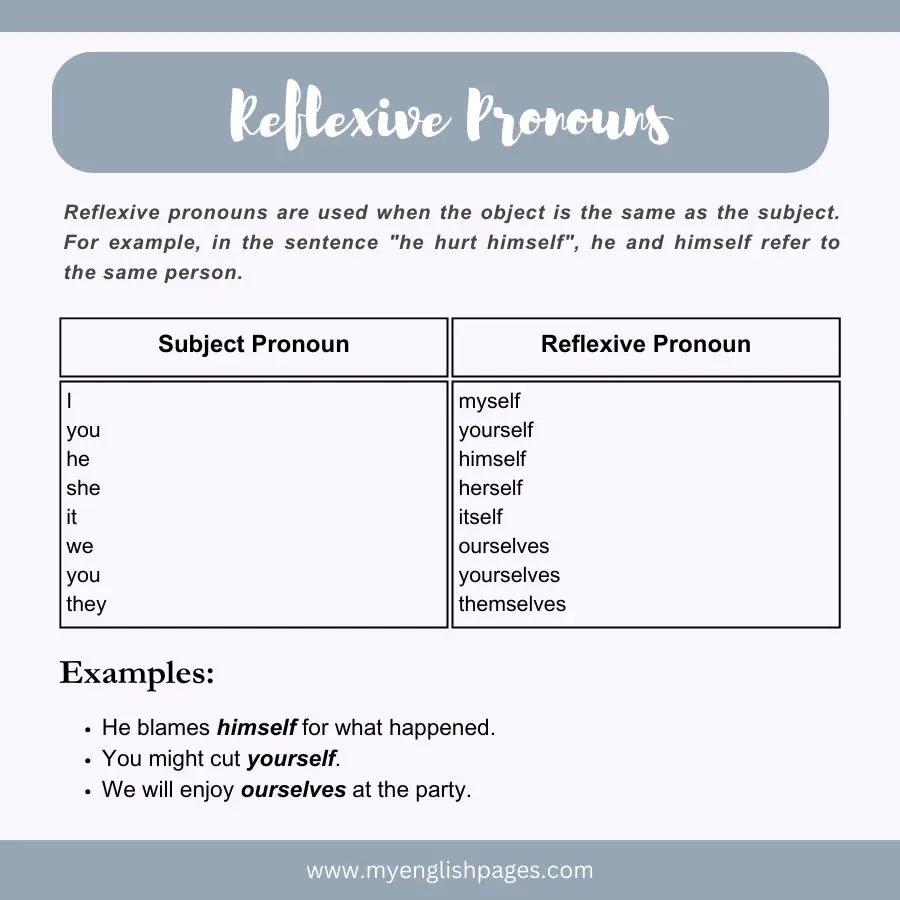Table of Contents
What are reflexive pronouns?
A dictionary definition of the adjective “reflexive” refers to something “directed or turned back on itself”
In grammar, reflexive pronouns are used when the object is the same as the subject. For example, in the sentence “he hurt himself“, he and himself refer to the same person.
Examples of reflexive pronouns include “myself“, “yourself“, “himself“, “herself“, “itself“, and “themselves“.
Examples:
- She was looking at herself in the mirror when I saw her. (“Herself” refers back to “she“.)
- They were enjoying themselves, celebrating their victory. (“Themselves” refers back to “They“.)
Forming Reflexive Pronouns
Reflexive pronouns are formed by combining a personal pronoun with the suffix “-self” (singular) or “-selves” (plural). The choice of the pronoun depends on the grammatical person and number of the subject. Here’s how you can form reflexive pronouns:
| My Your Him Her It Our Your (Plural) Them | + | self (for singular reflexive pronoun) selves (for plural reflexive pronoun) |
List of reflexive pronouns With Examples:
| Subject Pronoun | Reflexive Pronoun | Example |
|---|---|---|
| I | Myself | I treated myself to a spa day. |
| You (singular) | Yourself | Did you make this cake yourself? |
| He | Himself | James built the bookshelf himself. |
| She | Herself | She dressed herself for the event. |
| It | Itself | The cat groomed itself. |
| We | Ourselves | We organized the event ourselves. |
| You (plural) | Yourselves | Enjoy yourselves. After such hard work, your team deserves a vacation. |
| They | Themselves | They completed the project themselves. |

Uses Of Reflexive Pronouns
Reflexive pronouns are used for various reasons:
1. Reflexive Pronouns for Referring Back to A Subject
Reflexive pronouns are typically used to refer to a previously named noun or pronoun as in the following examples.
- She hurt herself
- John bought himself a bar of chocolate.
- He blames himself for what happened.
- You might cut yourself.
- We will enjoy ourselves at the party.
2. Reflexive pronouns For Emphasis
Reflexive pronouns are also used for emphasis. In this case, they are referred to as intensive pronouns. For example, in the sentence “I spoke to the president himself“, the speaker emphasizes that he spoke to the president personally NOT somebody else.
Compare the following examples:
- John bought himself a bar of chocolate. (“Himself” here is reflexive, referring back to John)
- John himself bought a bar of chocolate. (“Himself” here is intensive, emphasizing that it’s John who bought a bar of chocolate.)
Here are other examples of the intensive use of reflexive pronouns:

“I always do my homework myself. Nobody helps me.”

“He never does his homework himself. The teacher always helps him.”
In the above examples, the reflexive pronouns (i.e., intensive pronouns) can be removed without much change in meaning.
3. By + Reflexive Pronouns
The preposition “by” preceding a reflexive pronouns as in “By myself” means “alone” and ” without any help.”
Examples:
- I did the entire project by myself.
- James completed the challenging puzzle by himself.
- By itself, the machine can perform complex calculations.
Reflexive pronouns Functions In A Sentence
1. Reflexive Pronouns As Objects Of Verbs
Reflexive pronouns may function as a direct or indirect object of a verb in a sentence:
- Direct Object: Reflexive pronouns can function as direct objects when they receive the action of the verb directly.
- Examples:
- She washed herself after a long day at work.
- The cat groomed itself meticulously.
- Examples:
- Indirect Object: Reflexive pronouns can also act as indirect objects, indicating to whom or for whom the action of the verb is performed.
- Examples:
- He bought himself a gift to celebrate his achievement.
- Examples:
2. Reflexive Pronouns As Objects of Prepositions
Reflexive pronouns may be used as the object of a preposition:
- He made a cup of coffee for himself.
- He was talking to himself.
- She did the job by herself.
- Look at yourself!

Every morning…
I look at myself in the mirror.
3. Reflexive Pronouns Emphasizing Nouns
Reflexive pronouns are also used for emphasis. In this case, they are called intensive pronouns. Intensive pronouns can be removed without changing the meaning of the sentence.
- I met the king himself.
- The president himself announced the news.
- He sent the letter himself.
Position of Reflexive Pronouns
- After Verbs as Direct or Indirect Objects:
- Reflexive pronouns can appear after verbs, either as direct or indirect objects, indicating the action of the verb directed back to the subject.
Examples:- She treated herself to a day at the spa. (Direct object)
- He bought a new camera for himself. (Indirect object)
- Reflexive pronouns can appear after verbs, either as direct or indirect objects, indicating the action of the verb directed back to the subject.
- After Prepositions as Objects of Prepositions:
- Reflexive pronouns can also follow prepositions, serving as objects of the preposition to express actions involving or directed toward the subject.
Examples:- She went on a vacation by herself. (Object of the preposition “by”)
- They shared the news with themselves. (Object of the preposition “with”)
- Reflexive pronouns can also follow prepositions, serving as objects of the preposition to express actions involving or directed toward the subject.
- After Nouns as an Emphasis:
- Reflexive pronouns, when used for emphasis (intensive pronouns), can follow nouns to highlight or intensify the person or group involved.
Examples:- The president himself addressed the crowd. (Emphasis on the president)
- The team itself celebrated the victory. (Emphasis on the team)
- Reflexive pronouns, when used for emphasis (intensive pronouns), can follow nouns to highlight or intensify the person or group involved.
Common Mistakes in Using Reflexive Pronouns
While reflexive pronouns can add precision and emphasis to your language, there are common mistakes that often arise. Let’s explore some of these errors and understand how to avoid them:
1. Overgeneralization Of The Rule:
It is Incorrect to use “hisself,” “theirselves,” and “theirself” instead of “himself,” “themselves.” This mistake is probably due to the overgeneralization of a morphological rule (her + self = herself).
Example:
- Incorrect: “John praised theirselves for the effort.”
- Correct: “John praised themselves for the effort.”
2. Incorrect Usage With Plural Nouns:
It is inaccurate to use “themself” and “yourself” instead of “themselves” and “yourselves” when referring to plural nouns.
Example:
- Incorrect: “The team celebrated themself after the victory.”
- Correct: “The team celebrated themselves after the victory.”
3. Misuse Of Subject And Object Pronouns:
A common mistake with reflexive pronouns is the incorrect use of reflexive pronouns in place of subject or object pronouns. Ensure proper use of subject and object pronouns in sentences.
Examples:
- Incorrect: “Mr. Jordan and myself will give a talk about our new book.”
- Correct: “Mr. Jordan and I will give a talk about our new book.”
- Incorrect: “Myself will send the email.”
- Correct: “I will send the email.”
4. Incorrect Use of Objects Of Prepositions:
Another common mistake is the use of reflexive pronouns incorrectly as objects of prepositions. Choose the appropriate object pronoun.
- Example:
- Incorrect: “You may send the email to Mrs. Lynch or myself.”
- Correct: “You may send the email to Mrs. Lynch or me.”
Being mindful of these common pitfalls will enhance your command of reflexive pronouns, contributing to clearer and more polished communication.
FAQs
What is a reflexive pronoun, and can you provide examples?
A reflexive pronoun is a pronoun that reflects the action of the verb back onto the subject. Examples include “myself,” “yourself,” “himself,” “herself,” “itself,” “ourselves,” “yourselves,” and “themselves.” For instance, in the sentence “She dressed herself,” “herself” reflects the action back to the subject “she.”
What is the proper position for reflexive pronouns in a sentence?
Reflexive pronouns are placed in various positions based on their functions. They can appear after verbs as direct or indirect objects, after prepositions as objects of prepositions, or after nouns for emphasis. For example, “She treated herself,” “She went by herself,” and “The president himself addressed the crowd.”
How are reflexive pronouns formed?
Reflexive pronouns are formed by adding “-self” (singular) or “-selves” (plural) to personal pronouns. Examples include “myself,” “yourself,” “himself,” “ourselves,” etc.
Could you share examples of reflexive pronouns suitable for Class 7?
Certainly! Examples suitable for Class 7 include sentences like “I completed the homework by myself” and “They enjoyed the party all by themselves.”
In what way can reflexive pronouns be used effectively in sentences?
Reflexive pronouns are used for emphasis, to reflect the action back to the subject, or to indicate actions done alone. For example, “He himself solved the puzzle,” “She hurt herself”, or “She prepared the meal by herself.”
How do reflexive and intensive pronouns differ from each other?
Reflexive pronouns reflect the action back to the subject (e.g., “I did it myself”). Intensive pronouns, on the other hand, emphasize a preceding noun or pronoun (e.g., “John himself bought a new car”). While both end in “-self” or “-selves,” their functions in a sentence distinguish them. Additionally, removing intensive pronouns from a sentence doesn’t result in much change of meaning. Consider this example: “He himself sent the email” Vs. “He sent the email.” The same is not true for reflexive pronouns. You can’t say “She hurt”; you have to add the reflexive pronouns for the meaning to be complete: “She hurt herself.”
You may also be interested in:
Review:
| Personal pronouns | Possessive adjectives | Possessive pronouns | Reflexive pronouns | Object pronouns |
|---|---|---|---|---|
| I | my | mine | myself | me |
| you | your | yours | yourself | you |
| he | his | his | himself | him |
| she | her | hers | herself | her |
| it | its | its | itself | it |
| we | our | ours | ourselves | us |
| you | your | yours | yourselves | you |
| they | their | theirs | themselves | them |


